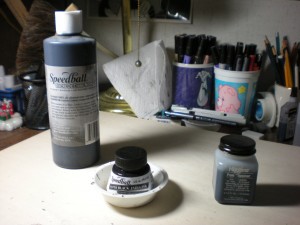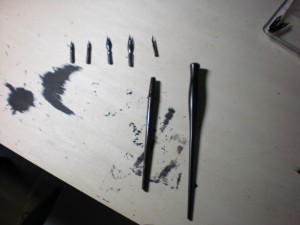And now, it’s time for probably the most important part of how to make comics – the big step that will make your work visible to readers. You’ve drawn your work in pencils and you’ve done your lettering. You think you’re all finished now? Well, you’d better think again! You need to draw your comics again – only this time you’ll be doing it in ink.
In comics lingo, this stage is called inking and a number of creators out there actually enjoy it. Some of you may be reading my posts where I share the pencilled pages of the fourth episode of Sunnyville Stories. You may notice that pencils do not reproduce well. This calls for a medium that does reproduce well. Ink has always been able to reproduce well so that’s what you’ll be using. Hmm…I’ll bet some of you are wondering if you have to use ink.
You don’t necessarily have to use ink. There are those out there who use collage to make comics. Some use stencils and/or scratchboard like Peter Kuper. And then, there are those of you who use the computer to create all of your comics. (On another note, I won’t be talking much about use of computers in my tutorials. But in a later post, I’ll clue you in on some good resources if you want to know more.) However, for the purposes of this tutorial, we’ll presume that you are using the traditional inking methods.
 Let’s start with the materials you’ll need. You’ll need ink of course. I recommend checking your local art supply store. Failing that, check office supply stores or stationery stores. If that’s a no go, you’ve got the Internet. Anyway, you need ink and it has to be black ink. It’ll need to be waterproof and give a rich even black on the page. In that photo there, you’ll see that I use Speedball Super Black india ink. Many of my comics are inked with that. On the far right, you’ll see a bottle of pen cleaner. You’ll need those for your pens and maybe your brushes (more on that in a moment).
Let’s start with the materials you’ll need. You’ll need ink of course. I recommend checking your local art supply store. Failing that, check office supply stores or stationery stores. If that’s a no go, you’ve got the Internet. Anyway, you need ink and it has to be black ink. It’ll need to be waterproof and give a rich even black on the page. In that photo there, you’ll see that I use Speedball Super Black india ink. Many of my comics are inked with that. On the far right, you’ll see a bottle of pen cleaner. You’ll need those for your pens and maybe your brushes (more on that in a moment).
Anyway, make sure your ink is waterproof – avoid any inks that are labeled “waterbased”, “nonwaterproof”, or “watersoluble”. On the other hand, beware of inks that are too thick, especially acrylic inks. Those can clog up your brush or pen and can be next to impossible to remove. You’ll need erasers too like plastic/rubber erasers and probably a kneaded eraser. Have a good set of straightedges too like rulers, T-squares, and triangles and maybe a French curve. As for inking tools, you’ve got some basic choices. Some out there prefer to use markers. These are disposable pens that usually give a flat consistent line. Some purists out there hate these pens, yet some pros like Mike Mignola (Hellboy) and DC comics superstars Neal Adams and Gil Kane have used markers to great effect. As for me, I prefer more traditional tools. I recommend getting some good brushes, dipping pens (check my early post for details) and at least one good technical pen (which I covered in-depth WAAAY back when I started my blog).
 So once you’ve got your tools, what do you do? Well, take your pencilled pages and start to draw over the pencil lines. Notice that I said to “draw” over the pencils, not to trace them. It’s important to remember that inking is NOT tracing. In spite of this, many out there still believe when they ink, you just trace over the pencils. Anyway, start first with the line art. Let that dry for awhile (at least a good thirty minutes) and then erase the pencil lines. From there, fill in black areas and…you know, I think it may be better to show rather than tell. You guys are just in luck. I have some videos of how I ink a drawing.
So once you’ve got your tools, what do you do? Well, take your pencilled pages and start to draw over the pencil lines. Notice that I said to “draw” over the pencils, not to trace them. It’s important to remember that inking is NOT tracing. In spite of this, many out there still believe when they ink, you just trace over the pencils. Anyway, start first with the line art. Let that dry for awhile (at least a good thirty minutes) and then erase the pencil lines. From there, fill in black areas and…you know, I think it may be better to show rather than tell. You guys are just in luck. I have some videos of how I ink a drawing.
[youtube]http://www.youtube.com/watch?v=TvhVlG7Ma6A[/youtube]
[youtube]http://www.youtube.com/watch?v=nc02VjzWP6w[/youtube]
[youtube]http://www.youtube.com/watch?v=GOmNxQ6snF4[/youtube]
[youtube]http://www.youtube.com/watch?v=uhQoElT5THQ[/youtube]
I hope those videos help to explain my inking techniques some more. Anyway, if you want more good resources on how to ink, I recommend the DC Comics Guide to Inking Comics by Klaus Janson. It’s probably one of the best resources out there on how to do inking. Another good piece to check out is the article “The Guy with the Dirty Fingers” by Rob Davis.
Any inkers out there reading this? How do you ink? What tools and techniques do you use? Please mention them in the comments section below. Next week, I plan to talk some more about inking by discussing one of the most complex of inking tools – the brush. So see all you next week.

Pingback: Sunnyville Stories Episode 4, page 7-8 pencils | Sunnyville Stories
Thanks for sharing. I should do stuff like this on my blog.
Inking is my favourite part of the job. I use a couple of Rotring Art Pens for the main line art and a brush and Windsor and Newton India Ink for the fills. Grey fills come from Pantone markers by Letraset. I put white detail over the black with brushes and dip pens in W&N white ink. This can take a couple of coats and I’m experimenting with acrylic white ink which covers better. I constantly clean my pens and brushes in water as I go and the acrylic hasn’t done any damage yet.
I plan to experiment with colour ink in the next book.
Thanks for commenting. I heard about the Rotring Art Pens; they’re quite similar to fountain pens and need a lot of maintenance from what I heard. Make sure you do clean your pens and brushes well. Acrylic can be next to impossible to remove once dry. I know because I keep a tube of white acrylic paint for corrections and I have to use cheap brushes to apply it since sooner or later, the brush becomes unusable.
Should you use color inks, make sure they are archival and lightfast. Some colored inks are actually dyes and are meant more for reproduction. They’ll fade with time. I found that Derwent Inktense pencils provide a nice vibrant colored ink. Plus this tin of watersoluble ink pencils takes up less space than a set of ink bottles!
Pingback: How I Ink a Comics Page, Part 1 | Sunnyville Stories